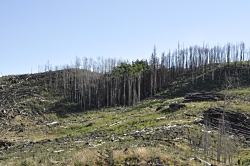
Courtesy & Copyright Karen Mock, Photographer
The rustling noise of wind blowing through aspen trees is a sweet sound for many Utahns, reminding them of home.Aspen Seedlings on the Brian Head Fire Footprint
The quaking aspen became Utah’s state tree in 2014. It grows in all 29 counties and is recognized by its off-white bark with black spots and streaks. In the fall, aspen’s heart-shaped leaves turn bright yellow and make a vibrant splash of color against backdrops of green conifers and rocky ridges.
In addition to its aesthetic value, aspen helps to create habitat for wildlife, provide shelter for livestock, and increase bird and plant diversity. In a fire, aspen burns less readily than other trees, so aspen forests can help reduce fire risk.
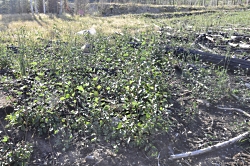
Courtesy & Copyright Karen Mock, Photographer
The aspens reproduce in two different ways. The most common way is they make root sprouts called “suckers”, which are genetically identical to the root, and can lead to the formation of a group of identical trees called a “clone”.
The second less common way is when aspen produce seeds, the seedlings have a mixture of genes from two parent trees. Aspen do not produce seeds every year, and seedlings can have a hard time getting established in dry soils.
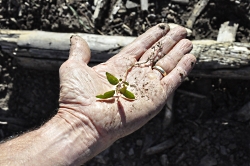
Rumor has it an early USU Forestry professor offered an A to any student who could find an aspen seedling in the wild, making the point of how rare the seedlings were. However, research at USU and elsewhere over the past decade is showing that aspen seedlings may be more common than we think, especially after fires.
In the summer of 2017, the Brian Head fire burned over 70,000 acres in the high country of southern Utah. Aspen is already playing a large role in the regeneration of this forest, producing a thicket of suckers under preexisting aspen
In July of this year, homeowners Mike and Julie Saemisch “Samish” in Brian Head, Utah were walking through some surviving aspens in the fire footprint, when they noticed something unusual and surprising – these aspens were producing an extraordinary amount of seeds.
They brought this to the attention of USU Professors Larissa Yocom, a fire ecologist, and Karen Mock, an aspen geneticist, both in the Department of Wildland Resources, in the Quinney College of Natural Resources.
Yocom said, “It looked like snow in July, there was so much aspen cotton draped over every surface.”
Mock visited the site in September to see whether these seeds were germinating. She explains, “Seedlings were everywhere – thousands and thousands of them, including in places where aspen did not previously exist”.
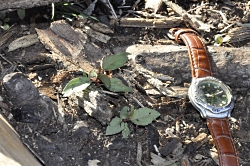
Courtesy & Copyright Karen Mock, Photographer
Courtesy & Copyright Karen Mock, Photographer
According to Yocom, “Fire has created a window of opportunity [for aspen] by opening up growing space [and decreasing competition]. It removed trees, shrubs, and understory plants that compete with small aspen. The [seedlings] have nutrients, water, sunlight, and open soil free from fallen leaves and vegetation.”
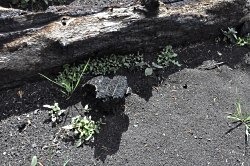
Courtesy & Copyright Karen Mock, Photographer
Mock explains, “All the right ingredients came together for this to happen: fire, seed production, and good monsoon rain timing. Events like this can present an opportunity for adaptive evolution, range expansion and range shifts in aspen, and those events can leave a mark for hundreds or thousands of years”.
Yocom adds, “A post-fire environment can be harsh with high temperatures at the soil surface and little shade. But if the seedlings survive through their most vulnerable stage they can grow quickly and may establish dominance across a huge area in the Brian Head Fire footprint.”
Yocom and Mock hope to study the survival of these aspen over the coming years, to find out which aspens survive and how big of an impact herbivory has on the suckers and seedlings. They hope that this research will help guide future post-fire management practices to encourage strong aspen regeneration after fires.
This is Shauna Leavitt and I’m Wild About Utah.
Aspen Seedlings on the Brian Head Fire Footprint-Credits:
Photos: Courtesy & Copyright © Karen Mock, Wildland Resources, Quinney College of Natural Resources, Utah State University, https://qcnr.usu.edu/directory/mock_karen
Audio: Courtesy Western Soundscape Archive, University of Utah, Sound provided by Jeff Rice, licensed under CCA-ND
Text: Shauna Leavitt, Utah Cooperative Fish and Wildlife Research Unit, Quinney College of Natural Resources, Utah State University
Aspen Seedlings on the Brian Head Fire Footprint-Additional Reading
Brian Head Fire Rehabilitation Project, USDA Forest Service, https://www.fs.usda.gov/project/?project=52918
Wildland Fire, Managing Land, USDA Forest Service, https://www.fs.fed.us/managing-land/fire
Donations, Working With Us, USDA Forest Service, https://www.fs.fed.us/working-with-us/donations
After the Fire, Pioneer Fire Reforestation on the Boise National Forest, USDA Forest Service, https://www.fs.fed.us/science-technology/fire/after-fire
Maffly, Brian, A year after southern Utah’s Brian Head Fire, the aspens are bouncing back in a surprising way that could strengthen the forest, The Salt Lake Tribune, Oct 22, 2018, https://www.sltrib.com/news/environment/2018/10/22/year-after-southern/
